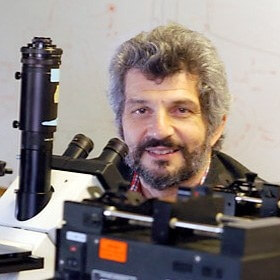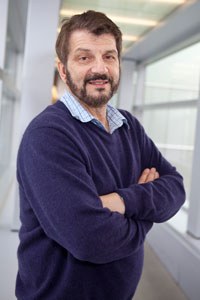News
David A. Weitz, Mallinckrodt Professor of Physics and of Applied Physics, who holds a joint appointment in the Harvard School of Engineering and Applied Sciences (SEAS) and the Department of Physics, was elected to the National Academy of Sciences (NAS).
Weitz, an expert in the physics of soft condensed matter and an entrepreneur, is among the 72 new members and 18 foreign associates from 14 countries receiving the honor in recognition of their distinguished and continuing achievements in original research.
To date, 9 SEAS faculty members, including Weitz, have been elected to the NAS.
Weitz and his group study the physics of soft condensed matter, materials easily deformed by external stresses, electric, magnetic or gravitational fields, and even thermal fluctuations.
The goal of this research is to probe and understand the relationship between mesoscopic structure and bulk properties. The group studies both synthetic and biological materials, with interests ranging from fundamental physics to technological applications and from basic materials questions to specific biological problems.
In addition to his involvement with Raindance technologies, a start-up microfluidics-based company, Weitz is the co-director of the BASF Advanced Research Initiative at Harvard, co-director of the Harvard Kavli Institute for Bionano Science & Technology, and director of the Harvard Materials Research Science & Engineering Center.
Weitz received his B.Sc. in Physics from the University of Waterloo and his Ph.D. in Physics from Harvard. Prior to his professorship at Harvard in 1999, he worked as a research physicist at Exxon Research and Engineering for nearly 18 years, leading the Interfaces and Inhomogeneous Materials Group and Complex Fluids Area, and held an appointment as a Professor of Physics at the University of Pennsylvania.
Other Harvard-affiliated newly elected members include:
- Porter W. Anderson, senior lecturer, Harvard Medical School, Boston
William G. Kaelin, investigator, Howard Hughes Medical Institute, and professor, Dana-Farber Cancer Institute, Harvard Medical School, Boston
Gary King, Albert J. Weatherhead III University Professor, department of government, Harvard University, Cambridge, Mass.
- Michael J. Hopkins, professor, department of mathematics, Harvard University, Cambridge, Mass.
Kenneth S. Rogoff, Thomas D. Cabot Professor of Public Policy and professor of economics, department of economics, Harvard University, Cambridge, Mass.
Donald B. Rubin, John L. Loeb Professor of Statistics, department of statistics, Harvard University, Cambridge, Mass.
Kevin Struhl, David Wesley Gaiser Professor, department of biological chemistry and molecular pharmacology, Harvard Medical School, Boston
- Mary C. Waters, M.E. Zuckerman Professor of Sociology, department of sociology, Harvard University, Cambridge, Mass.
###
The National Academy of Sciences (NAS) is an honorific society of distinguished scholars engaged in scientific and engineering research, dedicated to the furtherance of science and technology and to their use for the general welfare.
The NAS was signed into being by President Abraham Lincoln on March 3, 1863, at the height of the Civil War. As mandated in its Act of Incorporation, the NAS has, since 1863, served to "investigate, examine, experiment, and report upon any subject of science or art" whenever called upon to do so by any department of the government. Scientific issues would become even more contentious and complex in the years following the war. To keep pace with the growing roles that science and technology would play in public life, the institution that was founded in 1863 eventually expanded to include the National Research Council in 1916, the National Academy of Engineering in 1964, and the Institute of Medicine in 1970.
Topics: Awards, Applied Physics
Cutting-edge science delivered direct to your inbox.
Join the Harvard SEAS mailing list.
Scientist Profiles
David A. Weitz
Mallinckrodt Professor of Physics and of Applied Physics




